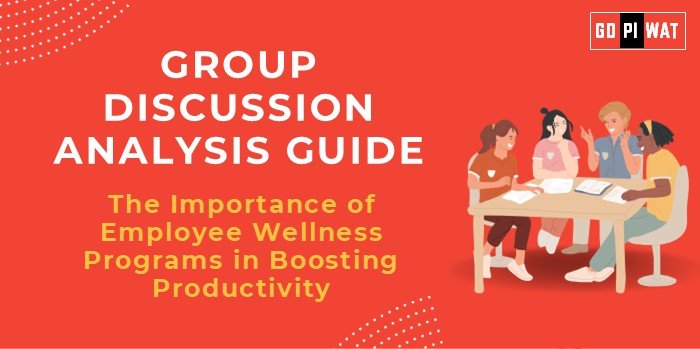📋 Group Discussion Analysis Guide
🌟 Topic: The Importance of Employee Wellness Programs in Boosting Productivity
🌐 Introduction to The Importance of Employee Wellness Programs
Globally, organizations are investing significantly in employee wellness programs to enhance productivity and foster a positive work environment. Companies like Google, Salesforce, and Unilever have made wellness initiatives a core strategy for organizational success. These programs, which promote physical health, mental well-being, and work-life balance, address rising stress and burnout rates while driving improved performance and retention.
📊 Quick Facts and Key Statistics
- ⚠️ Employee Burnout Rate: 44% of global employees report stress and burnout (Gallup, 2023).
- 💰 ROI on Wellness Programs: $3.27 return for every $1 spent through reduced healthcare costs and absenteeism (Harvard Business Review).
- 📈 Productivity Gains: Wellness programs can increase overall productivity by 5-12%.
- 🌍 Global Wellness Market: Valued at $61.2 billion (Global Wellness Institute, 2024).
🧑🤝🧑 Stakeholders and Their Roles
- Employers: Implement programs to enhance productivity and reduce turnover.
- Employees: Participate actively to improve personal health and performance.
- Healthcare Providers: Design solutions for comprehensive wellness.
- Governments: Promote wellness through policies and tax incentives.
🏆 Achievements and Challenges
✨ Achievements
- 📈 Enhanced Productivity: Fitness programs increased productivity by 12%.
- 📉 Reduced Absenteeism: Programs cut sick leave by 25% (WHO).
- 🔒 Improved Retention: 20-25% higher retention rates in companies with wellness initiatives.
- 🌍 Global Examples:
- Unilever reduced stress by 33% through wellness initiatives.
- Salesforce improved satisfaction scores with mindfulness training.
⚠️ Challenges
- 📉 Low participation—less than 50% engagement in wellness programs.
- 💸 High costs—SMEs struggle to afford extensive initiatives.
- 🔄 Sustainability—Programs often lose momentum over time.
🌍 Global Comparisons
- 🇯🇵 Japan: “Karoshi” prevention laws address overwork and promote wellness.
- 🇺🇸 USA: Companies like Google offer gym access, nutritious meals, and mental health counseling.
📝 Case Study
Google: On-site fitness centers, free meals, and mindfulness programs reduced turnover by 12% and increased employee satisfaction.
📐 Structured Arguments for Discussion
Supporting Stance
“Employee wellness programs enhance productivity, reduce absenteeism, and create a win-win for organizations and employees.”
Opposing Stance
“Wellness programs can be expensive and often fail without active employee participation.”
Balanced Perspective
“While wellness programs boost morale and productivity, their success depends on effective implementation and regular assessment.”
📣 Effective Discussion Approaches
- Statistical Start: “Companies with wellness programs see a 3:1 ROI through reduced absenteeism and healthcare costs.”
- Question-Based Opening: “Are wellness programs an investment or an expense? Let’s explore their impact on productivity.”
- Case Study Lead: “Google’s wellness initiatives improved employee satisfaction and reduced stress significantly.”
Counter-Argument Handling
Cost-effectiveness: “Wellness programs deliver up to a $3.27 ROI for every $1 invested.”
Low participation: “Engagement issues can be tackled through gamification, incentives, and tailored initiatives.”
📊 Strategic Analysis of Strengths and Weaknesses
- Strengths: Improves morale, reduces absenteeism, and enhances reputation.
- Weaknesses: High costs and low participation.
- Opportunities: Technology-driven wellness platforms and incentivization programs.
- Threats: Budget constraints for SMEs and poorly executed initiatives.
📚 Connecting with B-School Applications
- Real-World Applications: Wellness programs as strategic HR initiatives to improve performance.
- Sample Interview Questions:
- “How can wellness programs be integrated into a company’s performance strategy?”
- “Evaluate the cost-benefit analysis of implementing wellness initiatives in SMEs.”
- Insights for B-School Students:
- Link wellness strategies to employee performance metrics.
- Analyze wellness ROI frameworks for actionable insights.


